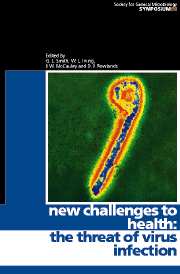Book contents
- Frontmatter
- Contents
- Contributors
- Editors' Preface
- 1 The viruses in our past, the viruses in our future
- 2 Dynamics and epidemiological impact of microparasites
- 3 The continuing threat of bunyaviruses and hantaviruses
- 4 Calicivirus, myxoma virus and the wild rabbit in Australia: a tale of three invasions
- 5 Potential of influenza A viruses to cause pandemics
- 6 The hepatitis viruses as emerging agents of infectious diseases
- 7 The emergence of human immunodeficiency viruses and AIDS
- 8 Morbilliviruses: dangers old and new
- 9 Structure–function analysis of prion protein
- 10 Endogenous retroviruses and xenotransplantation
- 11 Gammaherpesviral infections and neoplasia in immunocompromised populations
- 12 Structure and function of the proteins of Marburg and Ebola viruses
- 13 Epidemic dengue/dengue haemorrhagic fever as a public health problem in the 21st century
- 14 Borna disease virus – a threat for human mental health?
- 15 Antiviral drug development and the impact of drug resistance
- Index
4 - Calicivirus, myxoma virus and the wild rabbit in Australia: a tale of three invasions
Published online by Cambridge University Press: 06 July 2010
- Frontmatter
- Contents
- Contributors
- Editors' Preface
- 1 The viruses in our past, the viruses in our future
- 2 Dynamics and epidemiological impact of microparasites
- 3 The continuing threat of bunyaviruses and hantaviruses
- 4 Calicivirus, myxoma virus and the wild rabbit in Australia: a tale of three invasions
- 5 Potential of influenza A viruses to cause pandemics
- 6 The hepatitis viruses as emerging agents of infectious diseases
- 7 The emergence of human immunodeficiency viruses and AIDS
- 8 Morbilliviruses: dangers old and new
- 9 Structure–function analysis of prion protein
- 10 Endogenous retroviruses and xenotransplantation
- 11 Gammaherpesviral infections and neoplasia in immunocompromised populations
- 12 Structure and function of the proteins of Marburg and Ebola viruses
- 13 Epidemic dengue/dengue haemorrhagic fever as a public health problem in the 21st century
- 14 Borna disease virus – a threat for human mental health?
- 15 Antiviral drug development and the impact of drug resistance
- Index
Summary
INTRODUCTION
The history, ecology and genetics of the European rabbit and the two viruses, myxoma virus and calicivirus, used to control the rabbit in Australia offer a useful set of parallels and insights into the behaviour of such systems. In this review, the process of invasion of Australia by the rabbit and the consequent invasions of the Australian rabbit population by myxoma virus and a calicivirus are described.
THE RABBIT
The European rabbit (Oryctolagus cuniculus L.) evolved in what is now the Iberian Peninsula and southern France in Europe. During classic antiquity, mariners moved rabbits to islands in the Mediterranean. The species was then spread by human agencies across much of western Europe and, finally, during the age of European colonization of other parts of the world, populations were established on hundreds of islands and several continents (Thompson & King, 1994). The rabbit arrived in Australia from England with the first European settlers in 1788. Over the next 70 years, rabbits were repeatedly brought to Australia and on occasion either escaped or were released into the wild. While some of these populations survived and a few spread slowly, they did not thrive (Rolls, 1984; Stodart & Parer, 1988).
Invasion
In 1859, this pattern changed with the arrival in Australia of a shipment of 13 rabbits from near Glastonbury in England. These were taken to Barwon Park, a property near Geelong in Victoria, where they were cosseted as their numbers built up. Eventually they escaped or were released from their enclosures. They were also distributed as gifts by the owner to his friends and associates.
- Type
- Chapter
- Information
- New Challenges to HealthThe Threat of Virus Infection, pp. 67 - 88Publisher: Cambridge University PressPrint publication year: 2001
- 4
- Cited by



